“What is especially needed is great sensitivity: to look upon everything in the world as enigma….To live in the world as in an immense museum of strange things.” —Giorgio de Chirico
A few weeks ago I made a list of feature films that might be regarded as having the characteristics of a Thomas Pynchon novel without being based on any of Pynchon’s books. The post prompted several suggestions for other candidates, including recommendations to watch Jim Gavin’s TV series, Lodge 49, an American production that ran for two seasons from 2018 to 2019 before being cancelled due to low ratings. Having now watched the series I can say that I enjoyed it very much, and it is very Pynchonian, unsurprisingly when it not only gestures to the title of Pynchon’s second novel, The Crying of Lot 49, but also borrows from its storyline.
Ernie (Brent Jennings) has just been contemplating a print from the Ars Magna Lucis (1665) by Athanasius Kircher. Near the end of the second series he leaps through an image from the same book.
Lodge 49 presents a unique mélange of alchemy, surfing, secret societies, aerospace engineering, pool cleaning and cryptocurrency, with the added bonus of songs by the much-missed Broadcast being woven into the narrative. The series is consistently funny, humour being another essential Pynchonian ingredient, while the episodes are littered with references to (or correspondences with) Pynchon’s oeuvre: two of the main characters are an ex-surfer and an ex-sailor; the defunct aerospace company, Orbis, is modelled on Pynchon’s Yoyodyne from V. and Lot 49; there’s a trip to Mexico, a visit to an auction, and mention of a Remedios Varo exhibition (Lot 49 again); there are even references to Antarctic mysteries (V.), the Hollow Earth (Mason and Dixon) and the V-2 rocket (Gravity’s Rainbow). And those are only a few of the things I happened to catch as a first-time viewer. This is unusual territory for a small-scale television series, even if American TV has loosened up in recent years to allow a more eclectic range of material.
Larry (Kenneth Welsh) in the Sanctum Sanctorum with a plate from the Splendor Solis on the wall.
The Lodge 49 of the title is part of a global network of lodges that form the Ancient & Benevolent Order of the Lynx, a cross between a Masonic order and an occult cabal, founded by one Harwood Fritz Merrill, a Scottish alchemist, writer and explorer. (Merrill’s biography and the history of the Order of the Lynx is detailed here [PDF].) Alchemy is a persistent theme in the series but remains in the background for the most part, literally so inside Lodge 49 (Long Beach, California) and Lodge 1 (London) where the walls are decorated with prints of alchemical engravings. It would have been tempting to identify all of these pictures but most of them can be found in Taschen’s excellent Alchemy and Mysticism picture book so it’s easier to direct the curious to the Taschen volume. The prints also seemed to be there more to provide suitable set decoration rather than be significant in themselves, with one notable exception (see below).
Connie (Linda Edmond) going deeper into the mysteries of Lodge 1. The print is from Cabala, Spiegel der Kunst und Natur: in Alchymia (1615) by Stephan Michelspacher.
More intriguing was the appearance of several paintings which did seem significant although they might equally have been there to generate audience speculation. Film and TV drama is made today in the full awareness that every detail is liable to be screen-grabbed and scrutinised by obsessive viewers, a situation that offers the potential for directors and designers to incorporate details that may have no special significance but are simply there to fuel online chatter. It’s difficult to tell if this is what Gavin and co. were doing, especially when the prematurely truncated series contains so many loose ends and unexplained moments. But paranoia is in part the search for a significance that may not exist outside the mind of the paranoiac so a small degree of concern about being gamed by the creators of Lodge 49 seems warranted here, as well as adding to the general Pynchon factor. Despite all the Pynchoniana mentioned above the series is light on the paranoia that’s a constant in Pynchon’s novels so why not cultivate a little paranoia in the audience itself?
The first painting is seen in the office of Gloria (Jocelyn Towne), the HR manager at the soon-to-be-closed Orbis factory, and positioned in a manner that makes it impossible to miss. The identity of this one confounded me for a while; I knew it was a Symbolist painting I’d seen before but my initial guesses (Alexandre Séon?) were wrong. It’s Ulysses and Calypso (1882), an atypical piece by Arnold Böcklin. We later learn that Gloria is an unfulfilled artist but even if she wasn’t this is an unusual choice of picture for such a spare office.
The next painting is seen at the end of the same episode following the discovery of a secret room in Lodge 49. We see this picture throughout the rest of the series but it’s only referred to once in the script when someone describes it as “an emblem of the True Lodge” without explaining any further. The picture is actually the frontispiece by Julien Champagne from The Mystery of the Cathedrals (1926) by Fulcanelli, a curious book written pseudonymously by an otherwise unidentified author who claimed to be a genuine alchemist. (See Pauwels & Bergier’s The Morning of the Magicians or Kenneth Rayner Johnson’s The Fulcanelli Phenomenon for further details.) An ideal choice for the series, in other words, but prior to Lodge 49 this is about the last picture I’d expect to see turning up in a TV drama. Given the connections between Orbis and Lodge 49 it’s worth mentioning that the frontispiece as it appears in the book has an inscription beneath it: “The Sphinx protects and controls Science”.
At the beginning of season two Connie wakes up in the guest room at Lodge 1 which happens to have on the wall a painting by Giorgio de Chirico, The Enigma of a Day (1914). So far we’ve seen Symbolist art and plenty of alchemical art so why not have something from the Metaphysical School as well? I suspect this was a throwaway contribution by the set decorator but if so it’s a good choice.
Not a painting but a significant detail that I can’t help but note given the reading binge that led me here. The sixth episode of season two is one of the best for its temporal cross-cutting between Lodge 49 and the Orbis plant as they are in the present day, and as they were in the early 1960s. (There’s also an extended sequence soundtracked by Broadcast’s The Book Lovers.) As soon as Jackie Loomis (Cara Mantella) walked into an office filled with models of experimental rockets I knew there was going to be a V-2 somewhere in the room, and there it is on the sideboard behind her. This isn’t the only reference to Gravity’s Rainbow, however. In the same episode we also find out something about the mysterious Parabola Group, a Lodge 49 cabal at Orbis whose plans to channel their alchemical discoveries into weapons production echoes the intersection of warfare and parapsychology in the first part of Pynchon’s novel. And on the subject of parabolas, The Parabola Allegory just happens to be an alchemical Rosicrucian text…
From an obscure painting by Arnold Böcklin to the artist’s most famous picture…or one of them, since he painted five versions of The Isle of the Dead from 1880 to 1886. Böcklin described the painting as “a dream picture” so it’s fitting that we see it hanging on the wall of the Ludibrium clinic, an institution concerned with the study of sleep and dreams. Our attention is supposed to be on the typewriter but, once again, the positioning of the painting is suggestive, and this is a picture with a long history of being used as a symbolic icon.
Hopes that there might be a third series of Lodge 49 seem to have faded so any questions and mysteries are liable to remain unanswered. Or maybe not…the manifesto of Jim Gavin’s new publishing company mentions the possibility of there being “eccentric projects inspired by the world of Lodge 49“. In the meantime there’s some consolation in knowing that the series went out on a high, and that it won’t be spoiled by the deterioration that often sets in when a series runs for too long. Mass entertainment is always resistant to anything that’s too original or too clever so we have to be grateful that things like this can slide past the gatekeepers at all. As Trish Keenan sings in The Book Lovers: “Read the sign above the door / It’s not for everyone”.
Previously on { feuilleton }
• Pynchonian cinema
• Going beyond the zero
• Pynchon and Varo
• Thomas Pynchon – A Journey into the Mind of [P.]

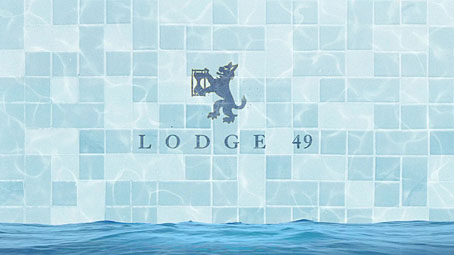
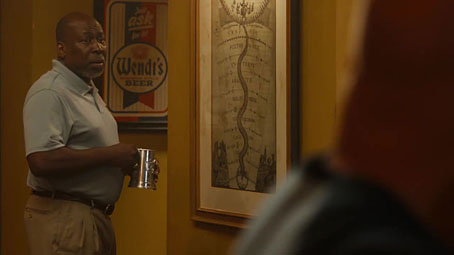
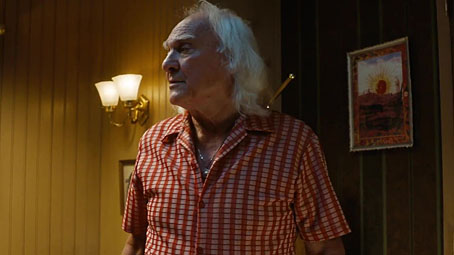
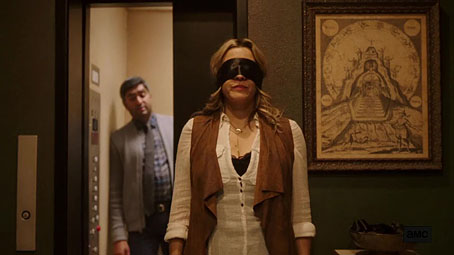
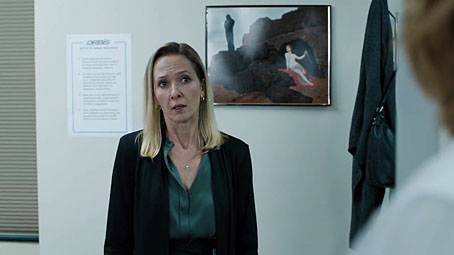
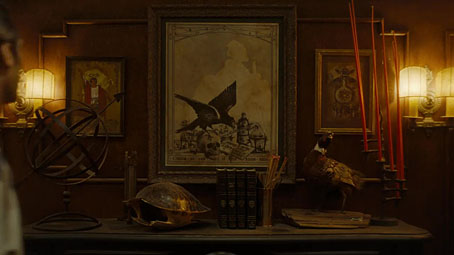
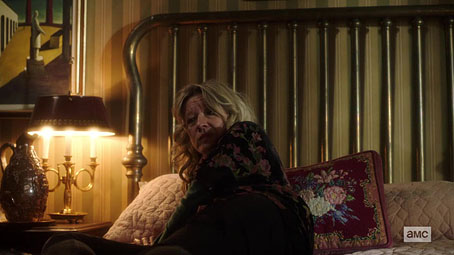
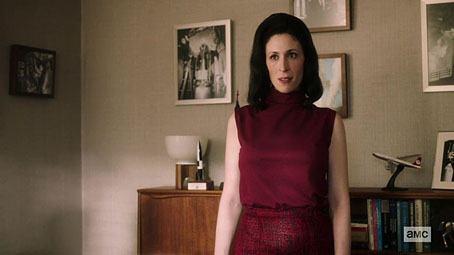
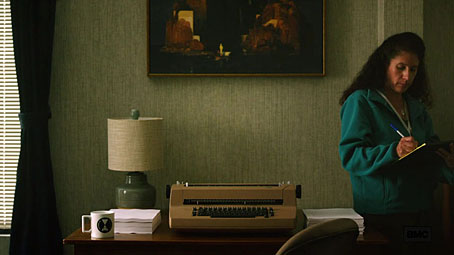
This is a great post—thank you!
Thanks, Angus.
I started watching it this week; it’s excellent.
Another note: I owe my taste for wheat beer to ‘The Crying Of Lot 49’; about thirty-five years ago, I was reading it for a second time. I was shopping for essentialsupplies in Tescos’ and as I walked along the beer aisle, I caught a glimpse of Thurn Und Taxis Weissbier; who was I to resist the call of serendipity?
That comma before the title of the series is very strange :)
Hello!
…..and many thanks for bringing this to my attention!
Just finished watching season 1 (excellent!) but cannot find access to season 2! How/where did you manage to view it?
Many thanks and all best wishes.
Hi eyeboystation. Someone said the series was available via Amazon but I can’t confirm this. I don’t use any streaming services–I don’t even watch YouTube very much–I found this one on a torrent site. If the series turns up on disc eventually I’ll be happy to buy it, it’s the kind of thing you’d want to watch again in future.
Thank you John!
Yes! Watched series 1 on Amazon. I’ll keep searching!
All best.
I mentioned this to a good friend and he managed to “source” both series for me. Started watching last night and I’m already nearing the end of series one. Great stuff, John, and much funnier than I’d expected so thanks for the recommendation.
Thanks, Stephen, that’s good to hear.